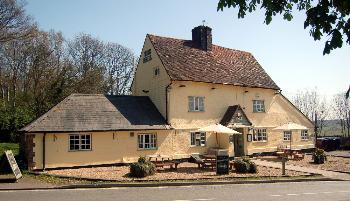The Bell Public House Studham

The Bell, April 2007
The Bell Public House: Dunstable Road, Studham
The Bell Public House was listed by the former Department of Environment in September 1980 as Grade II, of special interest. The department dated the building to the 17th century, noting that it was then heightened in the following century. The lower half is of colourwashed brick whilst the upper storey is partly colourwashed roughcast. It has an old clay tile roof. The rear is built of thin studded timber framing with brick infill. The building has a back-to-back fireplace with a central chimney stack.
Bedfordshire Archives has a run of deeds from 1502 relating to The Bell in Studham but, unfortunately, it is The Bell Inn at Markyate Street, what is now on the west side of Markyate High Street and, since 1897, in Hertfordshire. There is nothing, sadly, at Bedfordshire Archives to suggest how long the old building on Dunstable Road has been an inn. The first reference to it is in the countywide licensing registers of 1822 to 1828, when it was the only licensed premises in the village - the Bell in Markyate is listed separately under that part of Studham's other name of Humbershoe. Because the Bell was owned by breweries outside Bedfordshire there are very few references to it at Bedfordshire Archives.
The Bell was mentioned in the Bedfordshire Times of 22nd April 1848 in unfortunate circumstances under the heading MELANCHOLY SUICIDE: "On Friday week, the body of a man was found suspended by a handkerchief from the branch of a beech tree in Luton Park wood. On being cut down, it was discovered to be that of a man named Edward Howe, about 40 years of age. In his pockets were found a piece of mouldy bread, and part of a red herring; he appeared to be quite destitute. The unfortunate man was known in the neighbourhood as a pauper, and on the night before the sad event he slept at the 'Bell', in Studham; the landlady thought the poor man looked ill, but nothing was observed in his manner to excite suspicion. An inquest was held on the body before E. Eagles, Esq, and after hearing the evidence, a verdict of 'Found hanging', was returned by the jury". This may refer to the Bell in Markyate (then still a part of Studham) or to the one in the village, but more likely the latter as it is likely that a newspaper would refer to the one on Watling Street as being in Humbershoe or Markyate Street.
The Rating and Valuation Act 1925 specified that every piece of land and building in the country was to be assessed to determine the rates to be paid on it. Studham was assessed at the end of 1926 and the valuer visiting The Bell [ref: DV1/C/21/3] noted that the tenant Samuel Lowen paid Benskins Brewery Limited £15 per annum rent, which included a nearby field of one and a half acres.
The valuer noted a good tap room, a bar with two taps, a bar parlour, a cellar, a small sitting room and a kitchen downstairs with four bedrooms above. Outside was a brick, flint and slate range comprising stables with a loft over, a tap room and a urinal. There was also a weather-boarded and slate garage and three bay open-fronted cart shed and two brick, slate and flint pigsties. An old weather-boarded and felt army hut used for tea room completed the picture.
The valuer commented: "Notice up ‘Bed & Breakfast’. Does not let bedrooms". Trade averaged one and a half barrels and three dozen bottle of beer as well as a gallon of spirits a week. The valuer noted: "Tenant only been here 18 months. Does not know takings". He also commented: "Village very isolated. 3 pubs and 1 off licence in village. This is the best. Good buildings". By the 1960s the public house was owned by Allied Breweries.
The Bell remains a public house down to the time of writing [2010]. At a time when there is a high rate of closure for public houses Studham is lucky to retain both the Bell and the Red Lion in Church Road.
List of Licensees: note that this is not a complete list. Italics indicate licensees whose beginning and/or end dates are not known:
1822: Thomas Fellowes;
1841: James Challis
1861: Joshua Whitman;
1891: William Thorn;
1894: Esther Card;
1898: Algernon Sidney Morton;
1899: Henry John Peeling;
1900: William Aldridge;
1900: William Collins;
1901: Frederick Jones;
1902: William James Martin;
1903: Howard Read Reynolds;
1910: Henry Bettesworth [convicted on 16th October 1922 of supplying intoxicating liquor during prohibited hours; fined £3/3/-];
1925: Samuel Lowen;
1953: Richard George [aka George Richard] Maxey;
1977: Ronald Michael Harris;
1988: Colin David Arkley;
1993: Michael Frederick Kemp.
List of sources at Bedfordshire Archives:
- CL/P13: Register of alehouse licences: 1822 - 1828;
- PSL6/1: Register of Alehouse Licences: 1872-1901;
- PSL6/2: Register of Alehouse Licences: 1929-1954;
- Z1309/1/23a-b: Drawings of The Bell: 1994.